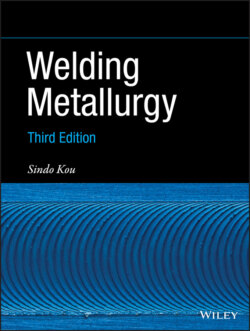Читать книгу Welding Metallurgy - Sindo Kou - Страница 46
1.4.2 Laser Beam Welding 1.4.2.1 The Process
ОглавлениеLBW is a process that melts and joins metals by heating them with a laser beam. The laser beam can be produced either by a solid‐state laser or a gas laser. In either case, the laser beam can be focused and directed by optical means to achieve high power densities. In a solid‐state laser, a single crystal is doped with small concentrations of transition elements or rare earth elements. For instance, in a YAG laser the crystal of yttrium‐aluminum‐garnet (YAG) is doped with neodymium. The electrons of the dopant element can be selectively excited to higher energy levels upon exposure to high‐intensity flash lamps, as shown in Figure 1.30a. Lasing occurs when these excited electrons return to their normal energy state, as shown in Figure 1.30b. The power level of solid‐state lasers has improved significantly, and continuous YAG lasers of 3 or even 5 kW have been developed. YAG laser has a wavelength is 1.06 μm, and it can be transmitted through fiber glass bundles.
Figure 1.30 Laser beam welding with solid‐state laser: (a) process; (b) energy absorption and emission during laser action.
Source: Welding Handbook [1]. Welding Handbook, Vol. 3, 7th Edition, © American Welding Society.
In a CO2 laser, a gas mixture of CO2, N2, and He is continuously excited by electrodes connected to the power supply and lases continuously. The CO2 laser has a wavelength of 10.6 μm, too long to be transmitted through fiberglass bundles. Higher power can be achieved by a CO2 laser than a solid‐state laser, for instance, 15 kW. Figure 1.31a shows LBW in the keyholing mode. Figure 1.31b shows a weld in a 13‐mm‐thick A633 steel made with a 15‐kW CO2 laser at 20 mm/s [18].
Figure 1.31 Keyhole laser‐beam welding: (a) process; (b) CO2‐laser weld in 13‐mm‐thick A633 steel.
Besides solid‐state and gas lasers, semiconductor‐based diode lasers and fiber lasers have also been developed. Diode lasers of 2.5 kW power and 1 mm focus diameter have been demonstrated [19]. Conduction‐mode (surface melting) welding can produce full‐penetration welds with a depth–width ratio of 3 : 1 or better in 3‐mm‐thick sheets. Fiber lasers, on the other hand, can provide highly focused laser beams. The wavelength is 1.06 μm [20].
